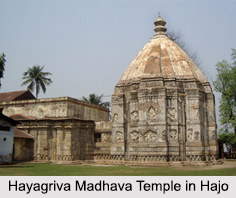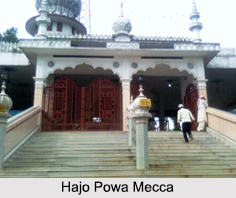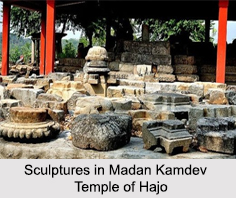 Hajo is an ancient pilgrimage center of three religions- Hinduism, Buddhism and Islam. The word Hajo has been derived from the word "Hajw", which means hill in Bodo language. The town is located at a distance of 24 km from Guwahati on the banks of the Brahmaputra River in Kamrup District of Assam. Hajo is surrounded with several temples and other sacred artifacts, among which Hayagriva Madhava Mandir is the most popular temple. The Kedareswara Temple, dedicated to Lord Shiva, has an inscription on its walls, which proves that the temple was built during the Rajeswar Singha period. Hajo is also famous for Powa Mecca which is the holy destination of Muslim community.
Hajo is an ancient pilgrimage center of three religions- Hinduism, Buddhism and Islam. The word Hajo has been derived from the word "Hajw", which means hill in Bodo language. The town is located at a distance of 24 km from Guwahati on the banks of the Brahmaputra River in Kamrup District of Assam. Hajo is surrounded with several temples and other sacred artifacts, among which Hayagriva Madhava Mandir is the most popular temple. The Kedareswara Temple, dedicated to Lord Shiva, has an inscription on its walls, which proves that the temple was built during the Rajeswar Singha period. Hajo is also famous for Powa Mecca which is the holy destination of Muslim community.
Legends of Hajo
According to the people of Hajo, they are Suryawanshi or the descendants of Surjo or Bila and are Kshatriyas. The Hajongs belong to the Indo-Tibetan group of the main mongoloid race. They had come from Tibet to the north-east India along the Brahmaputra and Tista and their tributaries. The tribe finally had spread over the Sankush Valley. Historians say that Hajongs were a section of the Indo-Burmese group of the Mongoloid race. The Hajong people claim that their ancestral home was in Hajo area, which comes under the Nalbari District of Assam in present day.
 Tourism in Hajong
Tourism in Hajong
There are several places for tourists, some of which are Hayagriva Madhava Temple, Hajo Powa Mecca, Madan Kamdev Temple, Kedareswara Temple and others. Sualkuchi is a nearby tourist destination of Hajo, which is popular for its Muga and Pat silk. Some of the tourist spots have been discussed in brief below:
Hayagriva Madhava Temple: This temple is located on the Manikut Hill and it was constructed by the King Raghudeva Narayan in the year 1583. According to the historians, the temple was first built by the Pala Dynasty, and later King Raghudeva reconstructed it. This stone temple houses an image of Hayagriva Madhava. Some Buddhists believe that Lord Buddha attained Nirvana in this temple. The presiding deity of this temple is the Hindu God Narasimha (Man Lion incarnation of Lord Vishnu). The rows of elephants are seen on the body of the temple and they are fine examples of Assamese art. There is a big pond called Madhab Pukhuri near the temple. Doul, Bihu and Janmastami festivals are celebrated every year in here. Apart from that, this temple preaches about both Hinduism and Buddhism, which attracts the Buddhist monks equally. Sayani, the first wife of Kalia Bhomora Borphukan donated a family of paiks and also a plot of land for their maintenance to the temple during the reign of King Kamaleswar Singha of Ahom Dynasty.
 Hajo Powa Mecca: It is a Muslim pilgrimage center, which is also known as Barmagam. It is situated on the top of the Garurachala Hills. An Iraqi Prince turned Preacher, Ghiyasuddin Auliya, is said to have built the mosque here in the 12th century A. D. According to the Muslims, the preacher brought a lump of earth from Mecca and enshrined on the spot, where the mosque is now situated. It is believed that by offering prayer here, one gains one-fourth (Poa) spiritual enlightenment and so this place is known as Poa-Mecca. However, a Persian epigraph indicated that the original mosque of Poa Mecca was built by Mir Lutfulla-e-Siraj in 1657 during the reign of Mughal Emperor Shah Jahan on this spot, which is not existed now. During the months of March and April, thousands of Hindu and Muslim pilgrims assemble here to celebrate Urs.
Hajo Powa Mecca: It is a Muslim pilgrimage center, which is also known as Barmagam. It is situated on the top of the Garurachala Hills. An Iraqi Prince turned Preacher, Ghiyasuddin Auliya, is said to have built the mosque here in the 12th century A. D. According to the Muslims, the preacher brought a lump of earth from Mecca and enshrined on the spot, where the mosque is now situated. It is believed that by offering prayer here, one gains one-fourth (Poa) spiritual enlightenment and so this place is known as Poa-Mecca. However, a Persian epigraph indicated that the original mosque of Poa Mecca was built by Mir Lutfulla-e-Siraj in 1657 during the reign of Mughal Emperor Shah Jahan on this spot, which is not existed now. During the months of March and April, thousands of Hindu and Muslim pilgrims assemble here to celebrate Urs.
Madan Kamdev Temple: It is an archaeological site located at a distance of 12 km from Hajo. This temple houses several erotic sculptures. There is a museum which stores archaeological findings of the place.
Visiting Information to Hajo
Changsari Railway Station and Lokpriya Gopinath Bordoloi International Airport are the nearest to reach the town. Hajo can also be reached by road through National Highway 427.



















